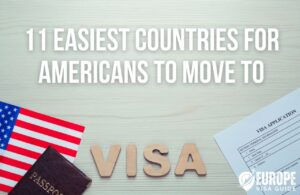
Table of Contents
Are you contemplating a move to Europe in 2024? If so, you’re likely seeking the easiest possible way to make the transition. With an increasing number of Americans and Brits relocating to Europe due to various factors such as a strong US dollar and political instability, it’s essential to have a comprehensive plan in place for your Europe immigration. In this guide, we will walk you through 11 essential tips for a smooth relocation to Europe, covering everything from choosing the right residency route to managing your finances and integrating into your new community. Let’s dive in and explore the key aspects of your European immigration.
1. Define Your Goals
The first step in your journey to move to Europe is to define your goals and narrow down which European country you wish to live in. Each country has its own set of rules and regulations for foreigners looking to reside there. As a US or UK citizen, you can enter the Schengen area and spend up to 90 days as a tourist. This allows you to explore different countries and cultures, helping you determine which one suits you best.
Additionally, it’s vital to decide how long you intend to stay in Europe. Are you planning a short-term stay as a digital nomad or seeking to relocate permanently? Your answer will determine the residency visa route you should choose. For short-term stays, explore countries offering digital nomad visas. If you plan to move permanently, you’ll need a long-term residency permit. Moreover, if obtaining EU citizenship is a long-term goal, consider countries with straightforward paths to citizenship.
2. Choose Your Residency Route
Once you have defined your goals and selected your target country, the next step is to determine the best residency route. While US passport holders can enter the Schengen area for 90 days, longer stays require a residency visa. Instead of relying solely on employment offers and work permits, consider routes designed for individuals who can support themselves financially.
European countries offer various residency options, such as retirement visas for those with passive income sources like pensions, rental income, investments, or dividends. Digital nomad visas are available for individuals working remotely for overseas employers, and investor residency programs, also known as Golden Visas, allow residency through investments in real estate or funds. Portugal is particularly known for offering a wide range of residency permit options, making it an attractive destination for Americans.
Before finalizing your decision, thoroughly review the application requirements for your chosen residency route. It’s crucial to allow sufficient time for the application process, which can take several months depending on the country. Additionally, ensure you have suitable travel insurance as it is often a requirement for most residency visas.
3. Understand Any Tax Implications
Relocating to Europe may have tax implications, making it essential to understand and prepare for them in advance. In most European countries, residing over 183 days automatically classifies you as a tax resident. Some countries, like Portugal, offer special tax treatment for new residents, potentially granting preferential tax rates.
Consulting a local tax advisor in your target country is highly recommended before applying for residency. Additionally, US citizens should be aware of their obligation to file annual tax returns with the IRS, as the US practices citizenship-based taxation. Seek advice from a US tax advisor to explore potential exemptions on foreign income.
4. Prepare Your Finances
Before your move, ensure you have online banking set up for all your US bank accounts. As you’ll be managing finances in multiple currencies, consider obtaining a cross-border bank account to handle transactions in different currencies. Wise, Revolut, and N26 are popular options that offer local accounts in various currencies, making them ideal for remote workers with international clients.
Once you become a resident in your target country, opening a local bank account with a national bank is advisable. This will facilitate day-to-day banking and simplify financial transactions within the country.
5. Sort Out Your Belongings
Deciding what to do with your belongings is an essential aspect of moving to Europe. For some, relocation provides an opportunity to downsize, making it possible to sell possessions through garage sales, online platforms, or donations to friends or charities. Alternatively, if you wish to keep your belongings with you, consider renting a storage unit while you settle into your new home in Europe.
Research the customs regulations of your target country, as some allow the import of one container duty-free, provided you can prove your residency status. To ensure a smooth transition, collaborate with a reliable global shipping company experienced in European customs procedures.
6. Decide Whether to Sell or Rent Out Your Property
If you own property in the US, it’s crucial to plan how to handle it when you move to Europe. For long-term or permanent moves, selling your US property is often the most practical choice. However, if you prefer to retain ownership, consider renting it out. Long-term tenants or platforms like Airbnb and Flatio offer options for short-term rentals. Hiring a property management service can help navigate the complexities of managing your property while living abroad.
Review your tenancy agreements, noting the notice period required before moving out. If you have a break clause, it might be advantageous to utilize it when appropriate.
7. Purchase Suitable Travel Insurance
Most residency visas in Europe require applicants to have travel insurance. This insurance should cover emergency medical treatment and repatriation in case of death. Once you obtain your official residence permit, you may gain access to state healthcare in many European countries, such as Portugal.
Even if you are embarking on a 90-day tourist trip, having insurance provides additional peace of mind. SafetyWing offers affordable and convenient travel insurance policies tailored to the needs of digital nomads and remote workers.
8. Set Up a Virtual Mailbox
Establishing a system to receive physical mail from organizations and services in your home country is crucial. A virtual mailbox service offers a practical solution by providing you with an address for receiving mail, which is then scanned and uploaded for online access. Alternatively, you can ask a reliable friend or family member to handle your physical mail while you’re abroad.
9. Renew Your Bank Cards
Before your departure, ensure you renew your bank cards and credit cards. It’s common for US banks to send new cards by mail to your US address. To avoid complications, try to renew them before moving to Europe, especially if they are due to expire soon. If necessary, consider changing your US banking address to that of a trusted friend or family member who can receive important mail, including new cards, on your behalf.
10. Renew Your Driver’s License
Renewing your driver’s license is another critical task to complete before moving to Europe. Each European country has its own regulations regarding driver’s licenses for foreign residents. Typically, you will need to exchange your US license for a local one within a specific timeframe after becoming a resident. Be aware of any expiration dates during the transition period, as you may need to retake your driving test in your new country. Familiarize yourself with the requirements and procedures applicable to your target country.
11. Find Groups and Activities in Your New City
Moving to a new country can be a daunting experience, often accompanied by feelings of isolation. Building new connections and a sense of community is crucial for a successful transition. Research Facebook groups, Meetup.com, and international communities in your target country or city to discover local activities and like-minded individuals. Platforms like Nomad Soulmates cater specifically to digital nomads seeking meaningful connections. Ensure your new destination offers opportunities to engage in hobbies or activities that interest you, as this will aid in your integration and overall well-being.
FAQs: How to Move to Europe
Q: What’s the easiest way to move to Europe? A: The easiest way for non-EU citizens to move to Europe is by applying for residency visas that don’t require employment in the target country. These visas include retirement visas, digital nomad visas, and investor residency programs such as Golden Visas.
Q: Can US citizens, or Americans, move to Europe? A: Yes, US citizens, or Americans, can move to Europe; however, the ease of the process depends on the specific European country. Each country has its own immigration rules, and individuals will need either a work permit or another type of residency visa. Options for Americans include retirement visas, digital nomad visas, and investor residency programs available in Europe.
Q: What’s the easiest European country to immigrate to? A: Portugal is often considered one of the easiest European countries to immigrate to. It offers a range of residency visas suitable for various individuals, including investors, remote workers, and retirees.
Q: What’s the fastest EU citizenship to obtain? A: Malta offers the fastest path to EU citizenship without marriage or family ties. Through the Malta Golden Visa route, individuals can obtain citizenship in just one year by investing at least €600,000. Other countries with relatively fast citizenship processes include Portugal, Luxembourg, Belgium, and Ireland, with a minimum residency requirement of five years.
Moving to Europe is a significant life decision that can transform your life. By following these 11 essential tips, you can ensure a smooth and successful relocation. As you plan your move, consider using Booking.com for the best deals on flights and accommodation throughout Europe.





